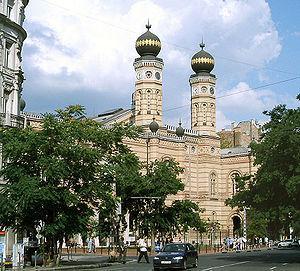
Budapest, zsinagóga (Photo credit: Wikipedia)
As a good tourist, we decided to visit one of the few special buildings in Budapest, which is the synagogue of the Jewish community in Hungary. Jews have lived in Hungary since the time of the Roman Empire, even before the Magyar (Hungarian) tribes arrived and conquered the land in the 9th century. By the early 20th century, the community had grown to constitute 5% of Hungary’s population and 23% of the population of the capital, Budapest.
The Dohány Street Synagogue, also known as The Great Synagogue is located in Erzsébetváros, the district VII of Budapest; it is the largest synagogue in Europe and the fifth largest in the world according to Wikipedia.
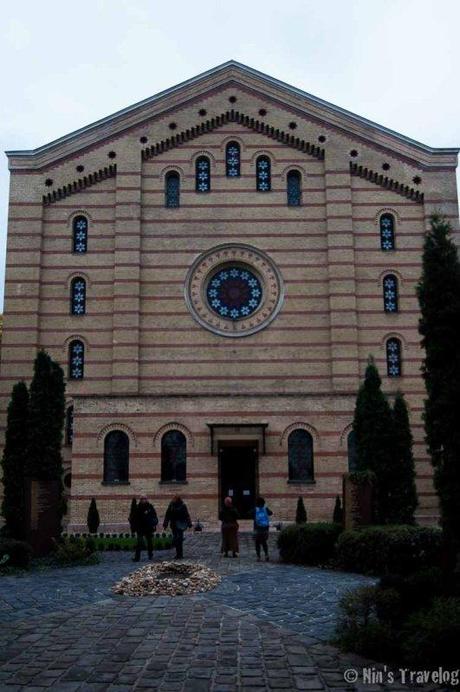
Rear view of the Synagogue with rose stained-glass
The architecture:
- The synagogue was built between 1854 and 1859 in the Moorish Revival style, believe it or not, it’s decoration based chiefly on Islamic models from North Africa and medieval Spain; its design also features a mixture of Byzantine, Romantic and Gothic elements. Two onion-shaped domes sit on the twin octagonal towers at 43 metres height. These towers symbolize the two columns of Solomon’s Temple.
- Similarly to basilicas, the building also consists of three spacious richly decorated aisles, two balconies and, unusually, an organ.
- A rose stained-glass window sits over the main entrance.
- The architect of the building, Ludwig Förster, believed that no distinctively Jewish architecture could be identified, and thus chose “architectural forms that have been used by oriental ethnic groups that are related to the Israelite people and in particular the Arabs”. And maybe that is why, during my visit to its museum, I met some Muslim students visiting the exhibition and making some notes.
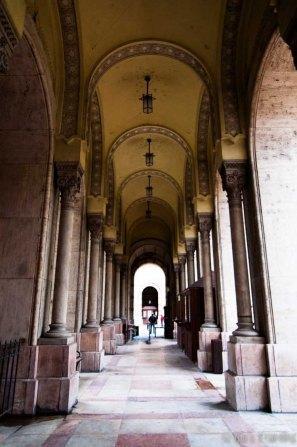 the corridor toward the museum
the corridor toward the museum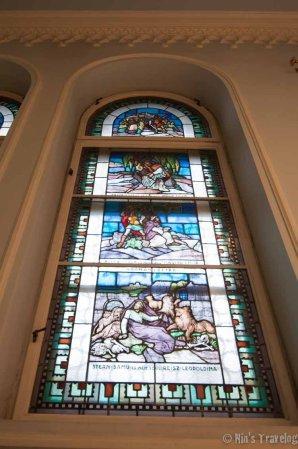 The famous stained glass window
The famous stained glass window


The Interior:
A single-span cast iron supports the 12-m wide nave. The seats on the ground-floor are for men, while the upper gallery has seats for women. Surprisingly the synagogue has an organ, though this instrument is used in Christian churches. The temple’s acoustic make it a popular venue for concerts.
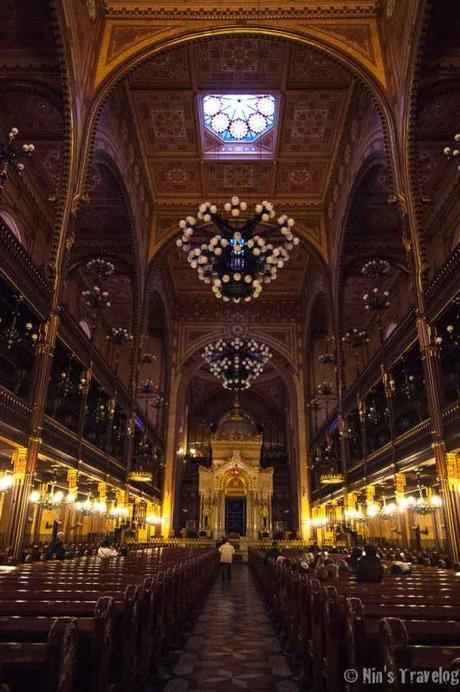
Single span cast iron at the main hall with organ behind the torah-arch
The torah-arch and the internal frescoes made of colored and golden geometric shapes are the works of the famous Hungarian romantic architect Frigyes Feszl.
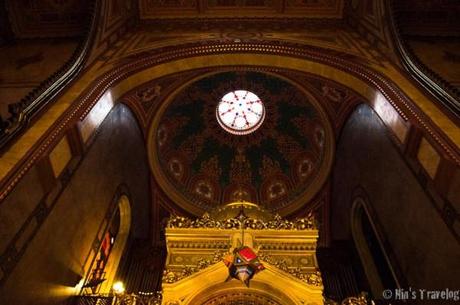
Torah-arch
In total, the building can house around 3000 people
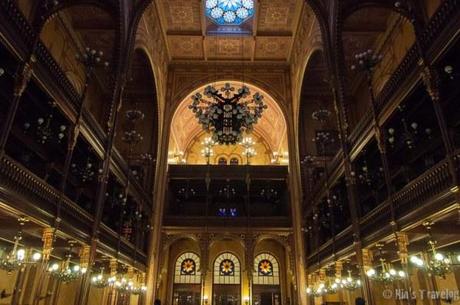
Seating area for women on the upper floor
Franz Liszt and Camille Saint-Saëns played the original 5,000 pipe organ built in 1859. Today, a new mechanical organ with 63 voices and 4 manuals was built in 1996 by the German firm Jehmlich Orgelbau Dresden GmbH
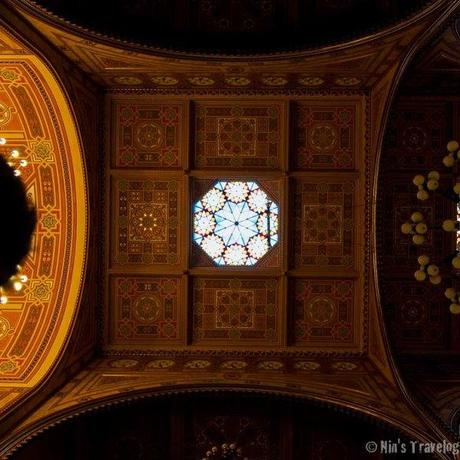
Rose stained glass at the ceiling of the main hall
To visit the synagogue you need to buy ticket at the gate. There are several websites dedicated to the location which provide information on when it is open and how much the current tickets cost. However tickets varied for every object in the complex, which consist of:
- the Great Synagogue,
- The Heroes’ Temple, which was added to the Great synagogue in 1931, and it serves as a memorial to Hungarian Jews who gave their lives during World War I.
- The graveyard, or the Jewish Cemetery, located in the backyard of the Heroes’ Temple. There are over 2,000 people buried here who died in the Jewish ghetto during the winter of 1944-45.
- The Jewish Museum, adjacent to the Great Synagogue was constructed on the site where Theodor Herzl’s house once stood. It features Jewish traditions, costumes, as well a detailed history of Hungarian Jews, including information about the Holocaust.
- The Holocaust memorial,
- The Raul Wallenberg Memorial Park. Home to the Holocaust Memorial, is located in the backyard of the Great Synagogue. also known as the Emanuel Tree, is a weeping willow tree (by Imre Varga) with the names of Hungarian Jews killed during the Holocaust inscribed on each leaf.
- Also part of the memorial is four red marble plates, commemorating 240 non-Jewish Hungarians who saved Jews during the Holocaust. One of the most heroic figures of the Holocaust in Hungary was Raoul Wallenberg, a Swedish diplomat who prepared Protective Passports under the authority of the Swedish Embassy, saving the lives of thousands of Jews.
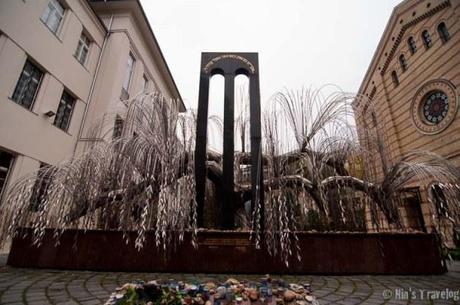
Emmanuel Tree – the weeping willow tree
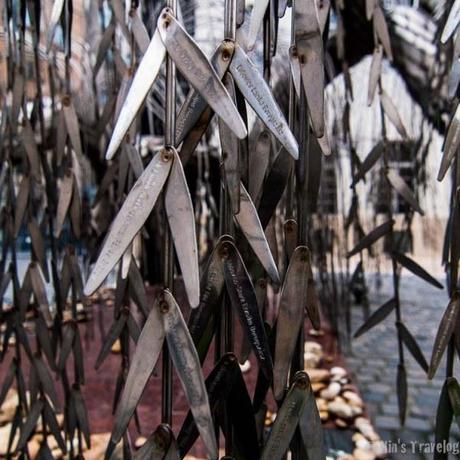
Names to remember on the Emmanuel Tree
History of the building:
The synagogue was bombed by the Hungarian pro-Nazi Arrow Cross Party just before WW II started. The building suffered severe damage from aerial raids during the Nazi Occupation.
During the Communist era the damaged structure became again a prayer house for the much-diminished Jewish community.
It was only in 1991 they start a restoration, and opened again for public in 1998.
Reference of this post:
- Dohány Street Synagogue – http://en.wikipedia.org/wiki/Dohány_Street_Synagogue
- Jewish Virtual Library – http://www.jewishvirtuallibrary.org/jsource/vjw/Hungary.html
- Visit Budapest.Travel – http://visitbudapest.travel/guide/budapest-attractions/great-synagogue/
